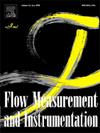非定常流流量测量在锐峰堰:见解从一个全面的实验数据集
IF 2.3
3区 工程技术
Q2 ENGINEERING, MECHANICAL
引用次数: 0
摘要
尖峰额定值曲线,传统上是由稳定流动条件推导出来的,已经被用于稳定和非稳定流动情况下的流量测量。尽管自20世纪60年代以来,许多研究都采用水库落差法来校准大型堰,但在水文曲线通过期间的流量测量数据仍然很少。本文研究了矩形和三角形尖顶堰在不同非定常强度下的非定常流动特性。建立了两个实验装置来收集数据并观察这些堰的性能。然后利用收集到的数据来评估在非定常工况下应用定常流量额定值曲线进行流量测量的准确性。引入了一种新的指标——相对环路宽度指数(RLWI),用于量化不稳定性对流量测量的影响,以及在使用常规稳态流量额定值曲线时的相关误差。研究结果表明,在非稳态条件下使用稳定流量曲线(在现场条件下占主导地位)可能导致水量估算误差在+ 10%到- 20%之间。此外,稳定流量等级曲线应用于水文通道的流量测量,往往高估峰值流量,预测峰值时间提前。灵敏度分析表明,堰的几何形状和库容对测量误差有显著影响。本文章由计算机程序翻译,如有差异,请以英文原文为准。
Unsteady flow discharge measurement over sharp-crested weirs: Insights from a comprehensive experimental dataset
Sharp-crested rating curves, traditionally derived from steady-flow conditions, have been used for discharge measurements in both steady and unsteady flow scenarios. Although numerous studies have employed the reservoir drawdown method to calibrate large weirs since the 1960s, data on flow measurements during the passage of hydrographs remain scarce. This article investigates the behavior of unsteady flow over rectangular and triangular sharp-crested weirs under various hydrograph shapes with differing intensities of unsteadiness. Two experimental setups were constructed to collect the data and to observe the performance of these weirs. The collected data were then used to evaluate the accuracy of applying steady-flow rating curves for discharge measurements under unsteady flow conditions. A new index, the Relative Loop Width Index (RLWI), is introduced to quantify the effects of unsteadiness on discharge measurements and the associated errors when utilizing conventional steady flow rating curves. The findings indicate that using steady-flow rating curves in unsteady conditions, which are dominant in field conditions, can result in errors in water volume estimation ranging from +10 % to −20 %. Furthermore, steady-flow rating curves applied to flow measurements during hydrograph passage tend to overestimate peak flows and predict earlier occurrence of peak times. Sensitivity analysis reveals that weir geometry and reservoir capacity significantly influence measurement errors.
求助全文
通过发布文献求助,成功后即可免费获取论文全文。
去求助
来源期刊

Flow Measurement and Instrumentation
工程技术-工程:机械
CiteScore
4.30
自引率
13.60%
发文量
123
审稿时长
6 months
期刊介绍:
Flow Measurement and Instrumentation is dedicated to disseminating the latest research results on all aspects of flow measurement, in both closed conduits and open channels. The design of flow measurement systems involves a wide variety of multidisciplinary activities including modelling the flow sensor, the fluid flow and the sensor/fluid interactions through the use of computation techniques; the development of advanced transducer systems and their associated signal processing and the laboratory and field assessment of the overall system under ideal and disturbed conditions.
FMI is the essential forum for critical information exchange, and contributions are particularly encouraged in the following areas of interest:
Modelling: the application of mathematical and computational modelling to the interaction of fluid dynamics with flowmeters, including flowmeter behaviour, improved flowmeter design and installation problems. Application of CAD/CAE techniques to flowmeter modelling are eligible.
Design and development: the detailed design of the flowmeter head and/or signal processing aspects of novel flowmeters. Emphasis is given to papers identifying new sensor configurations, multisensor flow measurement systems, non-intrusive flow metering techniques and the application of microelectronic techniques in smart or intelligent systems.
Calibration techniques: including descriptions of new or existing calibration facilities and techniques, calibration data from different flowmeter types, and calibration intercomparison data from different laboratories.
Installation effect data: dealing with the effects of non-ideal flow conditions on flowmeters. Papers combining a theoretical understanding of flowmeter behaviour with experimental work are particularly welcome.
 求助内容:
求助内容: 应助结果提醒方式:
应助结果提醒方式:


